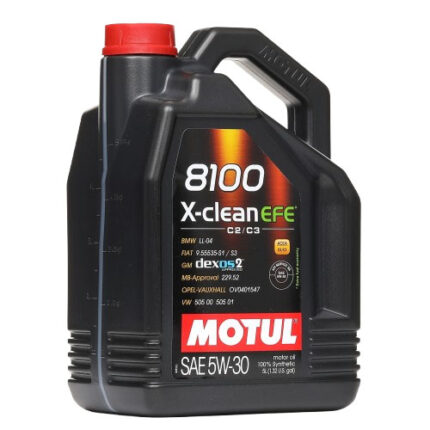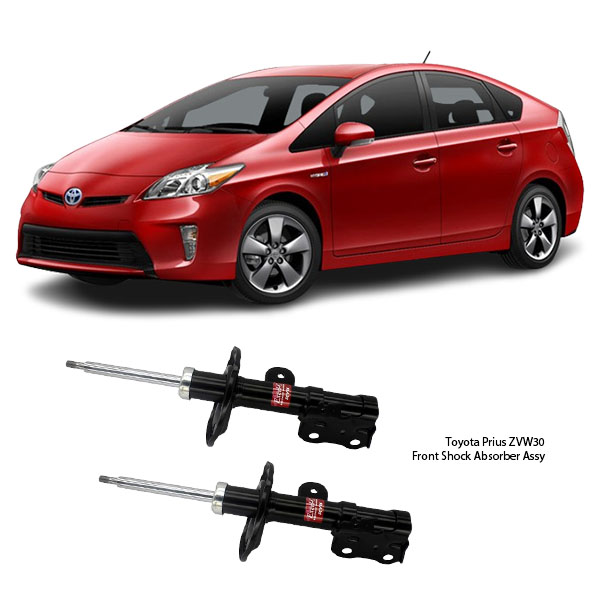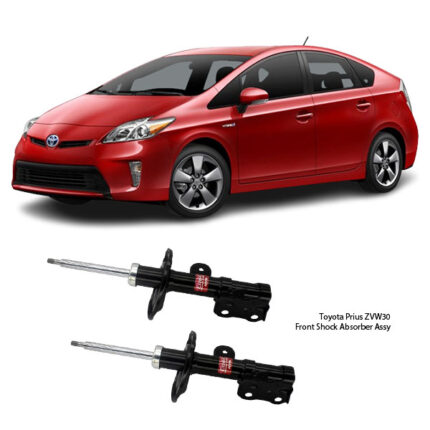Get Toyota Prius ZVW30 Front Shock Absorber Assy 339242 in Kenya
The Front Shock Absorber Assembly is one of the most critical elements of a vehicle’s suspension system. It ensures that the front wheels stay in contact with the road surface, providing vital support for steering control, braking stability, and ride comfort. While it may seem like a simple part, it plays a complex and essential role in how a vehicle behaves under various road conditions.
Every time a vehicle moves, especially over bumps or uneven terrain, the shock absorber controls and stabilizes the movement of the front suspension. Without it, the car would bounce uncontrollably, steering would become unpredictable, and driving would be both uncomfortable and unsafe.
What Is a Front Shock Absorber Assembly?
The Front Shock Absorber Assembly is the complete suspension component located at the front wheels. It includes:
-
Shock Absorber (Damper): A hydraulic or gas-charged cylinder that dampens suspension movement.
-
Piston and Rod: Move within the shock tube to provide resistance against compression and rebound.
-
Mounting Bushings and Hardware: Connect the shock to the chassis and control arm or strut tower.
-
Dust Boot: Protects the shock shaft from dirt and debris.
-
Bump Stop (Optional): Prevents bottoming out during hard compression.
In vehicles equipped with strut-type suspension, the front shock absorber often forms part of the MacPherson strut assembly, which combines the shock and spring into a single unit and bears some of the structural load of the vehicle. In non-strut designs, the shock works alongside a separate coil spring.
How Does a Front Shock Absorber Work?
The primary role of the front shock absorber is to control the rebound and compression of the front suspension springs. When a wheel hits a bump:
-
The suspension spring compresses, absorbing the shock from the road.
-
The shock absorber resists the rapid motion of the spring, using internal hydraulic fluid or gas pressure.
-
As the wheel returns to its normal position, the shock damps the rebound to prevent excessive bouncing.
-
This keeps the vehicle stable, ensures the tires stay on the road, and maintains steering precision.
Modern shock absorbers are often twin-tube or mono-tube in design and may be filled with oil or gas (usually nitrogen) for improved performance and reduced aeration (foaming).
Functions of the Front Shock Absorber Assembly
-
Control Wheel Movement: Ensures tires maintain contact with the road surface by damping vertical motion.
-
Improve Steering Response: Prevents front-end lift and body sway, keeping steering accurate and responsive.
-
Enhance Braking Stability: Minimizes forward pitch (nose-diving) during braking.
-
Reduce Wear and Tear: Limits excessive suspension movement that can damage other components.
-
Smooth Out the Ride: Absorbs road imperfections for a more comfortable driving experience.
Benefits of a Good Front Shock Absorber
-
Ride Comfort: Smooths out bumps, potholes, and road vibrations, providing a more comfortable cabin experience.
-
Better Vehicle Handling: Reduces body roll and keeps the vehicle more balanced through turns.
-
Improved Braking Efficiency: Keeps the front wheels grounded during braking, reducing stopping distance.
-
Reduced Suspension Wear: Dampens excessive motion, helping extend the life of control arms, bushings, and springs.
-
Enhanced Tire Longevity: Maintains even tire contact, preventing premature or uneven tire wear.
-
Safety and Stability: Provides more predictable behavior during evasive maneuvers or on uneven terrain.
Disadvantages of a Faulty or Worn Front Shock Absorber
-
Bumpy, Uncomfortable Ride: Excessive bouncing and jolting over rough surfaces.
-
Unstable Handling: Difficulty maintaining lane position or controlling the vehicle during turns.
-
Longer Braking Distances: The front end may dip too much, reducing traction and braking power.
-
Increased Body Roll and Dive: The car leans excessively in corners or dips forward when braking.
-
Tire Cupping and Uneven Wear: Due to the uncontrolled movement of the wheels.
-
Suspension Damage: Prolonged use of worn shocks leads to stress on ball joints, bushings, and springs.
Common Symptoms of a Worn Front Shock Absorber
-
Nose Diving During Braking: The front end dips excessively when the brake is applied.
-
Excessive Bouncing: The vehicle bounces more than once after hitting a bump.
-
Fluid Leaks: Hydraulic fluid leaking from the shock body indicates internal seal failure.
-
Clunking or Knocking Sounds: Noises from the front suspension may indicate loose or damaged shock mounts.
-
Steering Instability: Difficulty controlling the car, especially at higher speeds or on uneven roads.
-
Visible Damage or Corrosion: Cracks, dents, or rust on the shock body or mounting points.
-
Uneven Tire Wear: Telltale signs include feathering or cupping on the front tires.
Types of Front Shock Absorbers
-
Twin-Tube Shock Absorbers:
-
Common in passenger vehicles.
-
Uses two cylinders (inner and outer) to manage fluid and damping.
-
More affordable but can suffer from aeration under heavy use.
-
-
Mono-Tube Shock Absorbers:
-
Uses a single tube with a floating piston separating gas and fluid.
-
Offers better heat dissipation and consistent performance.
-
Typically used in high-performance or off-road vehicles.
-
-
Strut-Type Shock Absorbers (MacPherson Strut):
-
Combines the shock and coil spring into one load-bearing unit.
-
Compact and space-saving.
-
Common in modern front-wheel-drive vehicles.
-
-
Adjustable Shock Absorbers:
-
Allows manual or electronic adjustment of damping force.
-
Used in performance or luxury vehicles for driver-selectable comfort or sport modes.
-
When to Replace a Front Shock Absorber
Front shock absorbers generally last between 60,000 to 100,000 kilometers, depending on usage and driving conditions. You should consider replacement if:
-
You notice poor ride quality or handling.
-
There’s visible fluid leakage.
-
Unusual noises are coming from the front suspension.
-
You’re replacing other suspension components.
-
You’re planning a performance or heavy-duty upgrade.
Always replace shocks in pairs (both front shocks) to maintain balance and consistent handling.
How to Replace a Front Shock Absorber Assembly
Tools Needed:
-
Jack and jack stands
-
Wrenches and socket set
-
Spring compressor (if the shock is part of a strut assembly)
-
Torque wrench
-
Penetrating oil (for rusted bolts)
Basic Steps:
-
Lift the Vehicle: Secure the front end with jack stands and remove the wheels.
-
Access the Shock Mounts: Depending on the design, remove fasteners at the top and bottom mounting points.
-
Compress the Spring (if strut): Use a spring compressor carefully to disassemble a strut-type shock.
-
Install the New Shock: Mount the new assembly and torque bolts to the manufacturer’s specifications.
-
Reassemble and Test Drive: After installation, test the vehicle’s response to bumps and turns.
For strut-type assemblies, an alignment check or adjustment is often necessary after replacement.
Maintenance Tips
-
Routine Inspections: Check shocks for leaks or visible damage during oil changes or tire rotations.
-
Keep Suspension Clean: Wash off dirt and salt that can cause corrosion on mounts and seals.
-
Check After Rough Conditions: After long road trips, off-roading, or heavy loads, inspect the suspension components.
-
Watch Tire Wear: Irregular wear may signal shock or suspension issues early.
Follow us on Facebook for more parts.




